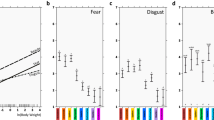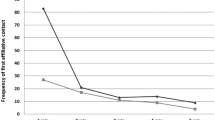Abstract
Researchers have widely used self-directed behaviors (SDB) as a behavioral indicator of anxiety in nonhuman primates. We examined if SDB rates in captive vervets (Cercopithecus aethiops) were associated with 1) proximity to conspecifics in general, 2) relative dominance rank of proximity partners, and 3) postconflict situations. Subjects were members of a captive group of vervets at the Lisbon Zoo, Portugal. The group comprised 3 males and 7 females, which were focal sampled for 10.5 h each. Vervets did not engage in more SBD while in proximity of conspecifics than while alone, and individual SDB rates were not generally influenced by dominance ranks of neighbors. Yet, victims of conflicts significantly increased their SDB rates after agonistic episodes, which is consistent with the view that SDB rates are an index of anxiety in Cercopithecus aethiops.



Similar content being viewed by others
References
Altmann, J. (1974). Observational study of behaviour: sampling methods. Behaviour, 49, 227–266. doi:10.1163/156853974X00534.
Aureli, F. (1997). Post-conflict anxiety in nonhuman primates: the mediating role of emotion in conflict resolution. Aggressive Behavior, 23, 315–328. doi:10.1002/(SICI)1098-2337(1997)23:5<315::AID-AB2>3.0.CO;2-H.
Aureli, F., & Schaffner, C. M. (2002). Relationship assessment through emotional mediation. Behaviour, 139, 393–420. doi:10.1163/156853902760102726.
Aureli, F., & van Schaik, C. P. (1991). Post-conflict behaviour in long-tailed macaques (Macaca fascicularis): II. Coping with uncertainty. Ethology, 89, 101–114.
Aureli, F., van Schaik, C. P., & van Hooff, J. A. R. A. M. (1989). Functional aspects of reconciliation among captive long-tailed macaques (Macaca fascicularis). American Journal of Primatology, 19, 39–51. doi:10.1002/ajp.1350190105.
Castles, D. L., & Whiten, A. (1998). Post-conflict behaviour of wild olive baboons: II. Stress and self-directed behaviour. Ethology, 104, 148–160.
Castles, D. L., Whiten, A., & Aureli, F. (1999). Social anxiety, relationships and self-directed behaviour among wild female baboons. Animal Behaviour, 58, 1207–1215. doi:10.1006/anbe.1999.1250.
Crawley, J. N., Ninan, P. T., Pickar, D., Chrousos, G. P., Linnoila, M., Skolnick, P., et al. (1985). Neuropharmacological antagonism of the beta-carboline-induced “anxiety” response in rhesus monkeys. The Journal of Neuroscience, 5, 477–485.
Das, M., Penke, Z., & van Hooff, J. A. R. A. M. (1998). Postconflict affiliation and stress-related behaviour of long-tailed macaque aggressors. International Journal of Primatology, 19, 53–71. doi:10.1023/A:1020354826422.
David, H. A. (1987). Ranking from unbalanced paired-comparison data. Biometrika, 74, 432–436. doi:10.1093/biomet/74.2.432.
David, H. A. (1988). The method of paired comparisons. London: C. Griffin.
de Vries, H. (1995). An improved test of linearity in dominance hierarchies containing unknown or tied relationships. Animal Behaviour, 50, 1375–1389. doi:10.1016/0003-3472(95)80053-0.
de Vries, H., Stevens, J. M. G., & Vervaecke, H. (2006). Measuring and testing steepness of dominance hierarchies. Animal Behaviour, 71, 585–592. doi:10.1016/j.anbehav.2005.05.015.
de Waal, F. B. M., & Yoshihara, D. (1983). Reconciliation and redirected affection in rhesus monkeys. Behaviour, 85, 224–241. doi:10.1163/156853983X00237.
Diezinger, F., & Anderson, J. R. (1986). Starting from scratch: a first look at a ‘displacement activity’ in group-living rhesus monkeys. American Journal of Primatology, 11, 117–124. doi:10.1002/ajp.1350110204.
Fairbanks, L. (1980). Relationships among adult females in captive vervet monkeys: testing a model of rank-related attractiveness. Animal Behaviour, 28, 853–859. doi:10.1016/S0003-3472(80)80145-X.
Fujisawa, K. K., Kutsukake, N., & Toshikazu, H. (2005). Reconciliation pattern after aggression among Japanese preschool children. Aggressive Behavior, 31, 138–152. doi:10.1002/ab.20076.
Hector, A. C. K., Seyfarth, R. M., & Raleigh, M. J. (1989). Male parental care, female choice and the effect of an audience in vervet monkeys. Animal Behaviour, 38, 262–271. doi:10.1016/S0003-3472(89)80088-0.
Kutsukake, N., & Castles, L. D. (2001). Reconciliation and variation in post-conflict stress in Japanese macaques (Macaca fuscata fuscata). Animal Cognition, 4, 259–268. doi:10.1007/s10071-001-0119-2.
Maestripieri, D., Schino, G., Aureli, F., & Troisi, A. (1992). A modest proposal: displacement activities as an indicator of emotions in primates. Animal Behaviour, 44, 967–979. doi:10.1016/S0003-3472(05)80592-5.
Manson, J. H., & Perry, S. (2000). Correlates of self-directed behaviour in wild white-faced capuchins. Ethology, 106, 301–317. doi:10.1046/j.1439-0310.2000.00527.x.
Mundry, R., & Fischer, J. (1998). Use of statistical programs for nonparametric tests of small samples often leads to incorrect P values: examples from Animal Behaviour. Animal Behaviour, 56, 256–259. doi:10.1006/anbe.1998.0756.
Ninan, P. T., Insel, T. M., Cohen, R. M., Cook, J. M., Skolnick, P., & Paul, S. M. (1982). Benzodiazepine receptor-mediated experimental anxiety in primates. Science, 218, 1332–1334. doi:10.1126/science.6293059.
Pavani, S., Maestripieri, D., Schino, G., Turillazzi, P. G., & Scucchi, S. (1991). Factors influencing scratching behaviour in long-tailed macaques (Macaca fascicularis). Folia Primatologica, 57, 34–38.
Raleigh, M. J., & McGuire, M. T. (1989). Female influences on male dominance acquisition in captive vervet monkeys, Cercopithecus aethiops sabaeus. Animal Behaviour, 38, 59–67. doi:10.1016/S0003-3472(89)80065-X.
Redmond, D. E., & Huang, Y. H. (1979). New evidence for a locus coeruleus-norephinephrine connection with anxiety. Life Sciences, 25, 2149–2162. doi:10.1016/0024-3205(79)90087-0.
Schino, G., Maestripieri, D., Scucchi, S., & Turilazzi, P. G. (1990). Social tension in familiar and unfamiliar pairs of long tailed macaques. Behaviour, 113, 264–272. doi:10.1163/156853990X00518.
Schino, G., Perretta, G., Taglioni, A., Mónaco, V., & Troisi, A. (1996). Primate displacement activities as an ethopharmacological model of anxiety. Anxiety, 2, 186–191. doi:10.1002/(SICI)1522-7154(1996)2:4<186::AID-ANXI5>3.0.CO;2-M.
Schino, G., Scucchi, S., Maestripieri, D., & Turillazzi, P. G. (1988). Allogrooming as a tension-reduction mechanism: A behavioural approach. American Journal of Primatology, 16, 43–50. doi:10.1002/ajp.1350160106.
Schino, G., Troisi, A., Perretta, G., & Mónaco, V. (1991). Measuring anxiety in nonhuman primates: Effects of lorazepam on macaque scratching. Pharmacology, Biochemistry, and Behavior, 38, 889–891. doi:10.1016/0091-3057(91)90258-4.
Sokal, R. R., & Rohlf, J. A. (1995). Biometry. New York: W. H. Freeman.
Spruijt, B. M., van Hooff, J. A. R. A. M., & Gispen, W. H. (1992). Ethology and neurobiology of grooming behavior. Physiological Reviews, 72, 825–852.
Troisi, A. (2002). Displacement activities as a behavioral measure of stress in nonhuman primates and human subjects. Stress (Amsterdam, Netherlands), 5, 47–54. doi:10.1080/102538902900012378.
Troisi, A., & Schino, G. (1987). Environmental and social influences on autogrooming behaviour in a captive group of Java monkeys. Behaviour, 100, 292–302. doi:10.1163/156853987X00161.
Acknowledgments
We thank Dr. Fernando Paisana for permission to conduct the study at the Lisbon Zoological Garden. We also acknowledge all reviewers, especially Brian Vaughn, whose criticisms helped us improve previous versions of the paper. A PRODEPIII/2002 grant awarded to J. R. Daniel provided funding for the study.
Author information
Authors and Affiliations
Corresponding author
Rights and permissions
About this article
Cite this article
Daniel, J.R., dos Santos, A.J. & Vicente, L. Correlates of Self-directed Behaviors in Captive Cercopithecus aethiops . Int J Primatol 29, 1219–1226 (2008). https://doi.org/10.1007/s10764-008-9300-7
Received:
Accepted:
Published:
Issue Date:
DOI: https://doi.org/10.1007/s10764-008-9300-7




